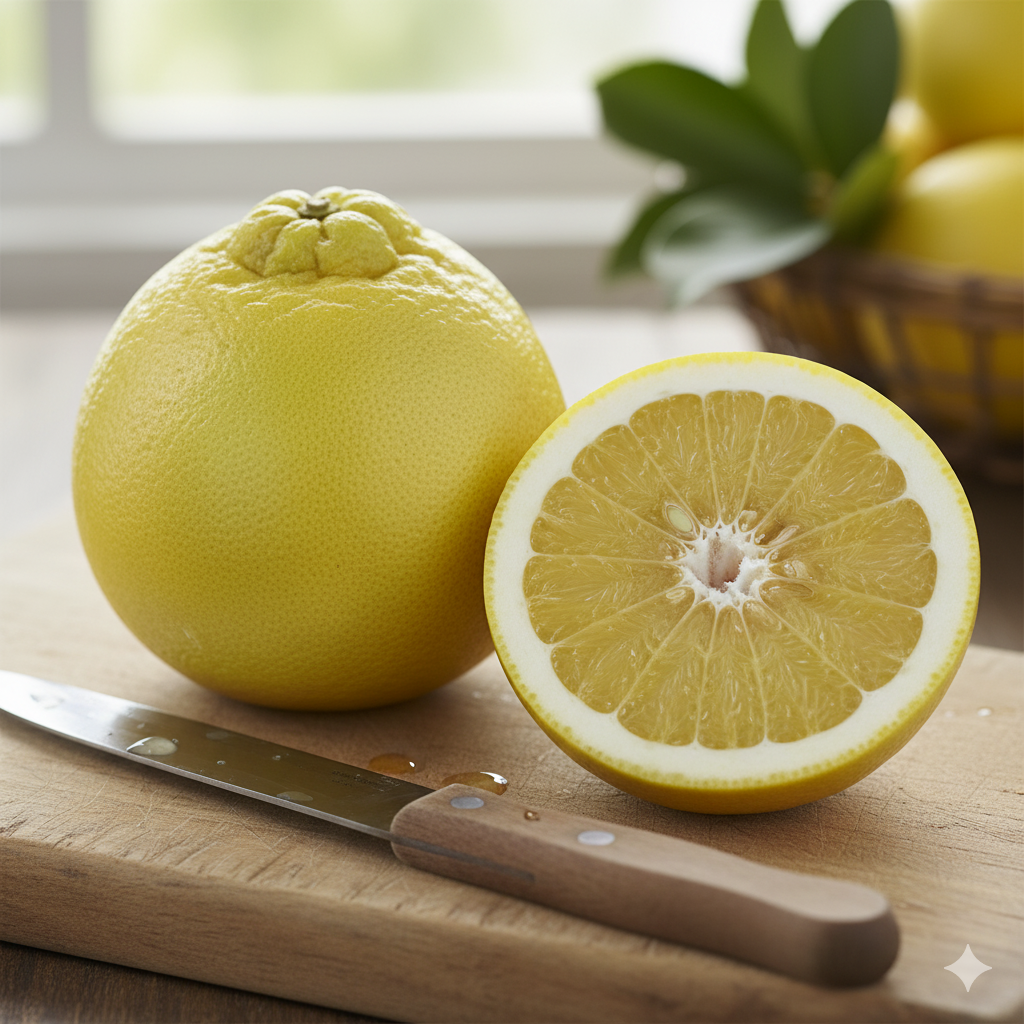A fruit is considered citrus because it belongs to the genus Citrus, which is part of the flowering plant family Rutaceae. This classification is based on shared botanical characteristics, most notably the structure of the fruit itself, the presence of specific aromatic oils, and a distinctive chemical composition.
The key features that define a citrus fruit are:
1. Botanical Structure: The Hesperidium
The most defining characteristic is the fruit’s specialized berry structure, known as a hesperidium. This structure includes:
- Leathery Rind (Exocarp/Mesocarp): A thick, protective outer peel containing volatile, fragrant citrus oils (limonene, etc.) in tiny glands. The colored outer layer is the flavedo, and the white spongy layer beneath it is the albedo.
- Segmented Flesh (Endocarp): The interior is divided into distinct, juice-filled segments or locules.
- Juice Sacs: The edible pulp is made up of numerous tear-shaped vesicles or juice sacs that contain the tart juice and essential organic acids (like citric acid).
2. Chemical Composition: Acidity and Flavor
Citrus fruits are defined by their unique chemistry, which gives them their signature tart flavor:
- Citric Acid: This is the dominant organic acid that gives citrus its characteristic sour or tart taste. All citrus fruits have high levels of citric acid, which is why they are referred to as acidic fruits.
- Essential Oils: The peel contains highly concentrated essential oils (like limonene), which give citrus fruits their sharp, distinctive aroma and flavor profile. These oils are chemically distinct from the flavors found in other fruits.
3. Shared Origin and Hybrids
All modern citrus varieties (oranges, lemons, limes, grapefruits, etc.) descend from just a few ancient ancestral species, such as the citron, pomelo, and mandarin orange.
- Nearly every citrus fruit consumed today is a hybrid of these three ancestral species. For example, the common sweet orange is a natural cross between the pomelo and the mandarin.
- Because they share this common genetic lineage and can easily be cross-bred, they remain classified under the same Citrus genus.
Which Fruits are Citrus?
Citrus fruits belong to the genus Citrus and include a wide variety of fruits characterized by their leathery rind, segmented flesh, and acidic juice.
Here is a list of the most common and popular citrus fruits, categorized by their family and common usage:
1. Primary Citrus Fruits (The Ancestors and their immediate forms)
These are the fundamental species from which almost all other commercial citrus fruits are hybridized.
- Mandarin Orange (Citrus reticulata): Includes common sweet oranges, tangerines, clementines, and satsumas. These are often small, easy-to-peel, and sweet.
- Pomelo (Citrus maxima): A very large, thick-rinded fruit that is less acidic than a grapefruit.
- Citron (Citrus medica): Known for its very thick peel and limited pulp; often used for candying the rind.
2. Common Hybrids (Everyday Fruits)
Most of the citrus fruits you find in the grocery store are complex crosses between the primary species.
| Fruit | Origin/Key Characteristics |
|---|---|
| Sweet Orange (C. $\times$ sinensis) | A hybrid of pomelo and mandarin. Includes Navel, Valencia, and Blood Oranges. |
| Lemon (C. $\times$ limon) | A hybrid of citron and bitter orange (which is a pomelo-mandarin cross). Known for its high acidity. |
| Lime (C. $\times$ aurantiifolia) | Generally smaller, highly acidic fruits, including the Persian, Key (Mexican), and Kaffir varieties. |
| Grapefruit (C. $\times$ paradisi) | A natural hybrid of pomelo and sweet orange. Known for its large size and slightly bitter taste. |
| Tangelo (C. $\times$ tangelo) | A hybrid of mandarin (or tangerine) and either a pomelo or grapefruit. The Minneola is a common variety. |
3. Lesser-Known and Specialized Citrus
These fruits are either regional specialties, recent hybrids, or used primarily for flavor.
- Limes: Finger Lime, Kumquat (technically belongs to a separate but closely related genus, Fortunella, but often classed with citrus), and Calamondin (or calamansi).
- Bitter/Sour Oranges: Seville Orange (often used for marmalade) and Bergamot (used to flavor Earl Grey tea).
- Exotic Fruits: Yuzu, Sudachi, and Buddha’s Hand.
What are the other Fruit Groups Apart from Citrus?
Apart from Citrus fruits (genus Citrus), fruits are broadly categorized into several other groups based on their botanical structure, climate of origin, and culinary uses.
Here are the main fruit groups:
1. Berries 🍓
In the culinary sense, berries are small, juicy, and often brightly colored fruits. Botanically, a true berry is a simple fruit produced from a single flower with a single ovary, and typically contains several seeds.
| Group | Examples |
| True Berries (Botanical) | Grapes, Bananas, Kiwis, Tomatoes, Blueberries, Cranberries |
| Aggregate Fruits (Culinary Berries) | Strawberries (accessory fruit), Raspberries, Blackberries |
2. Pomes
Pomes are a type of fleshy fruit produced by flowering plants in the rose family (Rosaceae). The edible flesh is derived from the receptacle (the base of the flower) that swells up and surrounds the central core containing the seeds.
| Examples | Characteristics |
| Apples, Pears, Quince | Have a tough outer skin, a fleshy center, and a core that contains seeds (pips). |
3. Drupes (Stone Fruits) 🍑
Drupes are fruits that develop from a single flower and contain a single, large, central pit or stone (the endocarp) that encloses the seed. They typically have a thin skin (exocarp) and a soft, fleshy middle (mesocarp).
| Examples | Characteristics |
| Peaches, Plums, Cherries, Apricots | Known for their smooth skin and large, hard center pit. |
| Olives, Mangoes, Coconuts (fibrous husk) | Also botanically classified as drupes. |
4. Melons and Gourds (Pepo) 🍉
These are large, fleshy fruits that belong to the family Cucurbitaceae (which also includes vegetables like squash). Botanically, they are a type of berry called a pepo, characterized by a hard, thick rind and fleshy, seeded interior.
| Examples | Characteristics |
| Watermelon, Cantaloupe, Honeydew | Defined by their watery, sweet flesh and thick, protective rind. |
5. Tropical and Exotic Fruits 🍍
This is a broad culinary group for fruits grown in tropical or subtropical regions that don’t neatly fit into other simple categories.
| Examples | Characteristics |
| Pineapple (multiple flowers fuse), Pomegranate (modified berry), Papaya, Avocado (large-seeded berry), Passion Fruit | Often unique in structure and flavor profile, requiring warmer climates to grow. |
Why do the French Call an Apple a Pomme and the Italians Call it a Mela?
The reason French uses pomme and Italian uses mela for “apple” is because the two languages evolved from Vulgar Latin by adopting and prioritizing different Latin terms that originally had the general meaning of “fruit.”
Essentially, French developed from a Latin term that meant “fruit in general,” while Italian developed from a Latin term that was specifically borrowed from Greek for a particular type of fruit.
French: Pomme (From Poˉmum) 🇫🇷
The French word pomme comes from the Latin word p\bar{o}mum.
- General Meaning: In Classical and Vulgar Latin, p\bar{o}mum meant “fruit” in a general sense, not just “apple.” The word later often appeared in the plural, p\bar{o}ma, which was used in Vulgar Latin to mean “apple.”
- Specialization: As the apple became the most common or representative fruit in the Gallo-Roman (French) region, the general term p\bar{o}mum specialized to mean the fruit par excellence: the apple.
- Legacy: The legacy of this general meaning persists in French compound words:
- Pomme de terre (potato) literally means “fruit of the earth” or “ground fruit.”
- The English word pomegranate comes from the Old French pome grenate (“seedy fruit”).
Italian: Mela (From Maˉlum/Meˉlum) 🇮🇹
The Italian word mela comes from the Latin word m\bar{a}lum (or later m\bar{e}lum).
- Greek Origin: The Latin m\bar{a}lum was borrowed from the Greek word μη~λoν (mêlon), which meant both “apple” and sometimes “fruit” in a general sense (and is also the root of the English word “melon”).
- Specificity: Unlike poˉmum, the Latin m\bar{a}lum was often used more specifically to refer to apples and other fruits of the apple-type.
- Evolution: Italian inherited the descendants of m\bar{a}lum, with the modern word mela evolving from the Late Latin plural form m\bar{e}la (meaning “apples”) being reinterpreted as a singular feminine noun in Italian.
| Term | Latin Root | Original Meaning | Modern Language |
| Pomme | P\bar{o}mum | General “Fruit” | French |
| Mela | M\bar{a}lum/Meˉlum* | General “Apple” (from Greek) | Italian |
Export to Sheets
This difference shows how the Romance languages, despite all descending from Latin, independently chose which of the various Latin and Greek terms for “fruit” would become their specific word for “apple.”
What do the Italians Call a Melon?
The standard Italian word for a sweet, round melon (like a Cantaloupe or Honeydew) is (melone).
However, the Italian language uses different, and often regional, words to distinguish between muskmelons (like Cantaloupe) and watermelons.
1. The Standard Sweet Melon
The general term for a sweet, non-watermelon variety (like the orange-fleshed Cantaloupe often served with prosciutto) is .
- Italian: (masculine noun)
- Etymology: Like many English and French words,
derives from the Latin m\bar{e}lop\bar{e}p\bar{o}, which came from the Greek term meaning “apple-gourd” or “ripe fruit.”
The Cantaloupe Connection
The name of the Cantaloupe melon actually comes from a location near Rome. The European variety was first grown in the 18th century at a papal estate called Cantalupo in Sabina, which is why the fruit is globally known as “cantaloupe.”
2. Watermelon (The Regional Split)
The term for watermelon (which is botanically a different species, Citrullus lanatus) is highly regional in Italy, with two main words dominating the North and Center:
| Word | Literal Meaning | Region Used |
| N/A (Derived from Greek angurion, meaning “cucumber”) | Northern Italy (widespread in the North) | |
| N/A (Derived from Latin Cucumis, meaning “cucumber/gourd”) | Central Italy, especially Rome (often considered the botanically appropriate term) |
Other Regional Terms
- (or
Mellone\ d’acqua): This literally translates to “water melon” and is often used in Southern Italy to clearly distinguish it from the sweet
melone (the cantaloupe/muskmelon).
- : A term used in Tuscany, sometimes referring to a muskmelon.
So that’s why the Americans say Cantaloupe, Because we Unwittingly Speak Italian
That’s a fun and mostly accurate way to look at it! While you aren’t “unwittingly speaking Italian,” you are definitely using a word that has a direct and significant Italian geographical root.
Here’s the breakdown of why Americans (and English speakers globally) use the Italian-linked name:
1. The Italian Origin: Cantalupo
The word Cantaloupe is a direct linguistic descendant of an Italian place name:
- The true European Cantaloupe melon was reportedly introduced to Europe from Armenia or Persia and first cultivated on a large scale in the early 18th century at the papal estate of Cantalupo (now Cantalupo in Sabina), near Rome, Italy.
- The name stuck, and when the melon was introduced to France, it became , which then passed into English as “cantaloupe.”
2. The Semantic Drift
The interesting part is that the Cantaloupe consumed in the U.S. and North America is actually a variety known as a Muskmelon (Cucumis melo reticulatus), which has the distinct netted, web-like skin.
- The true European Cantaloupe has a more deeply ribbed, warty, or smooth, non-netted rind.
- However, due to market preference and historical classification, the American netted muskmelon adopted the prestigious name “Cantaloupe” from the Italian estate.
So, while the word “Cantaloupe” is not Italian itself (it’s English, borrowed from French), the origin of the fruit’s identity and name is squarely in Italy.
It’s a great example of how the history of cultivation and trade shapes our everyday language!
What are the Esoteric Fruits of Each Group?
That’s a fun challenge! When thinking of “esoteric” fruits for a game like Pointless, we want fruits that fit the botanical groups but are uncommon, regionally specific, or rarely known by the general public.
Here are esoteric examples for each of the major fruit groups, designed to be obscure answers on a quiz show:
| Fruit Group | Common Fruit | Esoteric/Pointless Fruit | Notes |
| Citrus | Orange, Lemon | Buddha’s Hand (Citrus medica var. sarcodactylis) | An intensely fragrant citron variety with finger-like segments, almost no pulp or juice. |
| Lime | Australian Finger Lime (Citrus australasica) | Contains tiny, caviar-like juice vesicles (“citrus pearls”). | |
| Berries | Grape, Tomato | Black Sapote (Diospyros nigra) | A Persimmon relative with green skin and a chocolate-pudding-like black flesh. |
| Blueberry, Cranberry | White Currant (Ribes sativum) | A pale, translucent variety of red currant, much less common than its red or black cousins. | |
| Pomes | Apple, Pear | Medlar (Mespilus germanica) | A fruit that is hard and astringent until it is “bletted” (allowed to rot slightly) to become edible. |
| Quince | Serviceberry (Amelanchier alnifolia) | Also known as Saskatoon berry; a small pome fruit native to North America. | |
| Drupes (Stone Fruits) | Peach, Cherry | Ambrosia Peach | Not a botanical type, but a variety of peach known for intense sweetness, rarely marketed by its specific name. |
| Plum | Cornelian Cherry (Cornus mas) | A small, tart, bright red fruit that is botanically a drupe, despite the name. | |
| Melons & Gourds | Watermelon | Kajari Melon | An heirloom Indian variety known for its distinctive red-and-green striped skin and rich, sweet flavor. |
| Cantaloupe | Hami Melon | A large, sweet muskmelon originally cultivated in Hami, Xinjiang, China; common in Asia but esoteric elsewhere. | |
| Tropical | Mango, Pineapple | Jaboticaba (Myrciaria cauliflora) | Fruits grow directly on the trunk and branches of the tree (cauliflory); native to Brazil. |
| Banana, Kiwi | Miracle Fruit (Synsepalum dulcificum) | A berry that contains a protein called miraculin, which temporarily makes sour foods taste sweet. |
What about Oroblanco, would that be likely to be a ‘Pointless’ Citrus Fruit
That’s an excellent candidate for a “Pointless” citrus fruit!
The Oroblanco is definitely an esoteric answer that would score very low—or possibly even zero—on a typical public survey in the UK or US.
Here is why the Oroblanco would be a strong “Pointless” answer in the Citrus category:
Why Oroblanco is a Great Pointless Answer
- Low Name Recognition: Most people are familiar with lemons, limes, oranges, and grapefruits. The Oroblanco is sold in specialty stores, rarely stocked by major supermarkets, and is often overshadowed by its parent fruits.
- Specific Hybrid Status: The Oroblanco (and its close cousin, the Melogold) is a relatively recent, intentional hybrid.
- It is a cross between a Pomelo and a Grapefruit (specifically, a Siamese Sweet Pomelo and an acidless Marsh Seedless Grapefruit).
- Its name is Spanish for “White Gold,” which is not commonly known outside of horticulture circles.
- Unique Characteristics: The fruit was specifically bred to have the grapefruit’s size but none of its bitterness. It has a very thick, green-yellow rind and a sweet, pale yellow flesh. People who buy it are usually seeking it out specifically for its non-bitter taste, not grabbing it casually.
Conclusion:
If the Pointless category was simply “Name a Citrus Fruit,” Oroblanco would be a brilliant, low-scoring answer. The general public would almost certainly stop after the common citrus names, leaving the field clear for this obscure hybrid.




